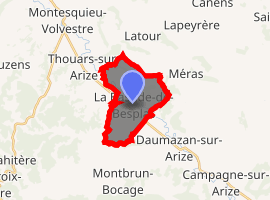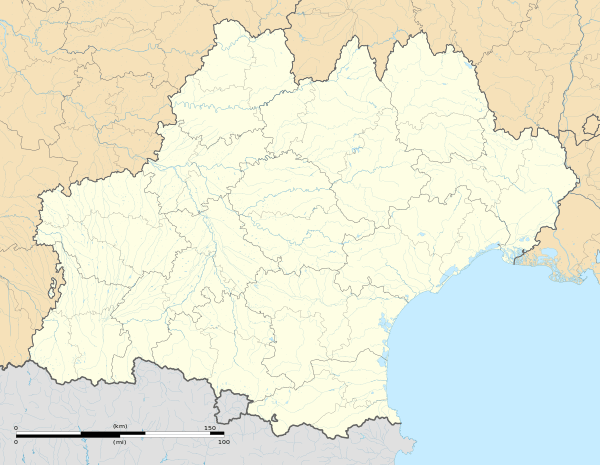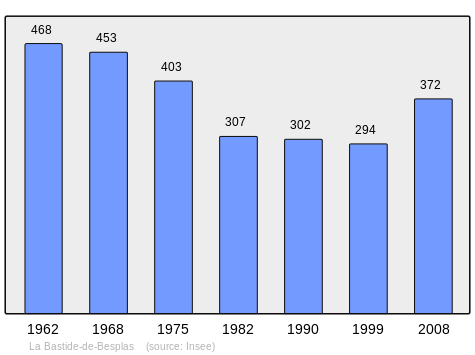La Bastide-de-Besplas
La Bastide-de-Besplas is a commune in the Ariège department in the Occitanie region of south-western France.[2]
La Bastide-de-Besplas | |
|---|---|
Location of La Bastide-de-Besplas 
| |
 La Bastide-de-Besplas  La Bastide-de-Besplas | |
| Coordinates: 43°10′03″N 1°16′32″E | |
| Country | France |
| Region | Occitanie |
| Department | Ariège |
| Arrondissement | Saint-Girons |
| Canton | Arize-Lèze |
| Government | |
| • Mayor (2014–2020) | Nicolas Gareia |
| Area 1 | 10.22 km2 (3.95 sq mi) |
| Population (2017-01-01)[1] | 380 |
| • Density | 37/km2 (96/sq mi) |
| Time zone | UTC+01:00 (CET) |
| • Summer (DST) | UTC+02:00 (CEST) |
| INSEE/Postal code | 09038 /09350 |
| Elevation | 234–391 m (768–1,283 ft) (avg. 225 m or 738 ft) |
| 1 French Land Register data, which excludes lakes, ponds, glaciers > 1 km2 (0.386 sq mi or 247 acres) and river estuaries. | |
The inhabitants of the commune are known as Besplasois or Besplasoises.[3]
Geography
La Bastide-de-Besplas is an old Bastide in the Massif de Plantaurel some 50 km south by south-west of Toulouse and 20 km west by north-west of Pamiers. Both the northern and southern borders of the commune are the departmental border with Haute-Garonne. Access to the commune is by the D628 from Montesquieu-Volvestre in the north-west which passes through the centre of the commune and the village and continues south-east to Daumazan-sur-Arize. The D326 branches off the D628 in the commune and goes north to join the D408 north of the commune. The commune is mostly farmland interspersed with some forest.[4][5]
The Arize river flows through the centre of the commune and the village flowing from south-east to north-west where it continues to join the Garonne at Carbonne. The TaiVades stream rises in the north of the commune and flows north-west forming part of the northern border before joining the Arize on the commune border. The Ruisseau de Bergou forms the south-eastern border as it flows south-west to join the Arize. The Ruisseau d'Argain forms the southern border of the commune as it flows east to join the Arize in Daumazan-sur-Arize commune.[4][5]
History
La Bastide-de-Besplas appears as la Bafude de Besplas on the 1750 Cassini Map[6] and as la Bailute on the 1790 version.[7]
Administration
| From | To | Name | Party | Position |
|---|---|---|---|---|
| 2001 | 2014 | Jean-Pierre Bernabé | ||
| 2014 | 2020 | Nicolas Gareia |
(Not all data is known)
Demography
In 2010 the commune had 390 inhabitants. The evolution of the number of inhabitants is known from the population censuses conducted in the commune since 1793. From the 21st century, a census of communes with fewer than 10,000 inhabitants is held every five years, unlike larger communes that have a sample survey every year.[Note 1]
| 1793 | 1800 | 1806 | 1821 | 1831 | 1836 | 1841 | 1846 | 1851 |
|---|---|---|---|---|---|---|---|---|
| 205 | 558 | 665 | 674 | 675 | 725 | 706 | 732 | 720 |
| 1856 | 1861 | 1866 | 1872 | 1876 | 1881 | 1886 | 1891 | 1896 |
|---|---|---|---|---|---|---|---|---|
| 726 | 720 | 724 | 724 | 741 | 652 | 653 | 625 | 601 |
| 1901 | 1906 | 1911 | 1921 | 1926 | 1931 | 1936 | 1946 | 1954 |
|---|---|---|---|---|---|---|---|---|
| 575 | 556 | 568 | 523 | 527 | 513 | 506 | 466 | 461 |
| 1962 | 1968 | 1975 | 1982 | 1990 | 1999 | 2006 | 2010 | - |
|---|---|---|---|---|---|---|---|---|
| 468 | 453 | 403 | 307 | 302 | 294 | 357 | 390 | - |

Culture and heritage
Religious heritage
The Chapel of Notre-Dame-du-Bout-du-pont (1663)![]()
The Chapel contains many items that are registered as historical objects:
- A Commemorative plaque (1728)

- A Ceiling Mural (18th century)

- A Statue: Christ on the Cross (16th century)

- A Retable (17th century)

The Parish Church also contains many items that are registered as historical oobjects:
- A Painting: The beheading of Saint John the Baptist (17th century)

- A Bronze Bell (1410)

- A Statue: Saint Louis (18th century)

- A Statue: Virgin and child (17th century)

- A Statue: Saint John the Baptist (18th century)

- A Chalice (19th century)

- An Offering Cross (19th century)

- A Chalice (19th century)

- A Group Sculpture: Virgin of Pity (18th century)

Notable people linked to the commune
- Louis Astre, French trade unionist, born in the commune, where his parents were teachers, and spent his early years there.
- Henri Cuq, French Politician
- Abbot Casy Rivière
See also
Notes and references
Notes
- At the beginning of the 21st century, the methods of identification have been modified by Law No. 2002-276 of 27 February 2002, the so-called "law of local democracy" and in particular Title V "census operations" allows, after a transitional period running from 2004 to 2008, the annual publication of the legal population of the different French administrative districts. For communes with a population greater than 10,000 inhabitants, a sample survey is conducted annually and the entire territory of these communes is taken into account at the end of the period of five years. The first "legal population" after 1999 under this new law came into force on 1 January 2009 and was based on the census of 2006.
References
- "Populations légales 2017". INSEE. Retrieved 6 January 2020.
- La Bastide-de-Besplas on Lion1906
- Inhabitants of Ariège (in French)
- La Bastide-de-Besplas on Google Maps
- La Bastide-de-Besplas on the Géoportail from National Geographic Institute (IGN) website (in French)
- la Bafude de Besplas on the 1750 Cassini Map
- la Bailute on the 1790 Cassini Map
- List of Mayors of France (in French)
- Ministry of Culture, Mérimée PA00093772 Chapel of Notre-Dame-du-Bout-du-pont

- Ministry of Culture, Palissy PM09000090 Commemorative Plaque

- Ministry of Culture, Palissy PM09000089 Ceiling mural

- Ministry of Culture, Palissy PM09000088 Statue: Christ on the cross (in French)
- Ministry of Culture, Palissy PM09000087 Retable (in French)
- Ministry of Culture, Palissy PM09000965 PM09000079 Painting: The beheading of Saint John the Baptist

- Ministry of Culture, Palissy PM09000078 Bronze Bell

- Ministry of Culture, Palissy PM09000086 Statue: Saint Louis

- Ministry of Culture, Palissy PM09000085 Statue: Virgin and child

- Ministry of Culture, Palissy PM09000084 Statue: Saint John the Baptist

- Ministry of Culture, Palissy PM09000083 Chalice

- Ministry of Culture, Palissy PM09000082 Offering Cross

- Ministry of Culture, Palissy PM09000081 Chalice

- Ministry of Culture, Palissy PM09000080 Group Sculpture: Virgin of Pity

| Wikimedia Commons has media related to La Bastide-de-Besplas. |